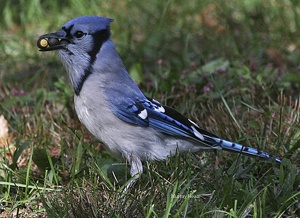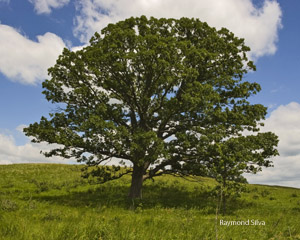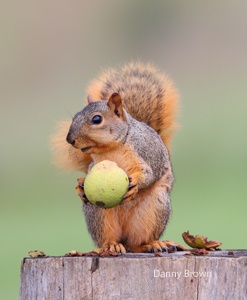We have much more to do and your continued support is needed now more than ever.
The Wildlife Benefits of Acorns and Oaks
The time of year has come during which, when I’m reading in the evening in the silence of my home, I hear a sharp thwack! on the roof, followed by an increasingly quieter bump bump bump bump.

We all know that from tiny acorns mighty oak trees grow, but we should add that from tiny acorns also grow deer, gray squirrels, red squirrels, chipmunks, wild turkeys, crows, flying squirrels, rabbits, opossums, blue jays, quail, raccoons, wood ducks—more than 100 U.S. vertebrate species eat acorns. In autumn and winter, the acorn is the cheeseburger of the forest ecosystem—fairly easy to find and nicely packaged. They are one of the most valuable food resources available for wildlife.
Acorns as Food
Like wine, acorns come in two basic types: red and white, depending on the type of oak they come from. About 90 of the world’s 400 oak species are native to the United States. White oaks, which grow leaves with rounded lobes and drop acorns every year, include species such as the chinkapin, swamp chestnut oak, live oak and post oak. The red oaks (sometimes called black oaks), which bear leaves with pointed lobes and drop acorns every other year, include scrub, willow, southern red, blackjack and black oak.

However, acorns from white oaks germinate shortly after nestling into the earth, while reds lie dormant for months, meaning that reds will be available as a food longer. Wildlife will turn to nuts from the red-oak group in winter and into spring, when the white varieties are gone.
Acorns can compose more than 75 percent of a white-tailed deer’s diet in late fall and early winter. Deer and other animals, including black bears, alter their distribution patterns in response to acorn production. When an acorn crop is especially good, deer may produce more twin fawns, thanks to improved nutrition. A failed acorn season can cause wildlife populations dependent on acorns to decline.
Acorn Generations
A single oak tree can produce thousands of acorns in one season. My patio in autumn can become covered with acorns, like a carpet of crunchy ball bearings, and a walk in the backyard can turn into a gauntlet of pelting acorns, stinging to head and shoulders. The blasted acorns are everywhere.
Which raises a point you may find interesting. Wild things have two strategies for ensuring that they produce enough offspring to keep the species going—individuals of some species mature fast, produce a lot of young, and die soon (think mice or rabbits); in other species, individuals mature slowly, reproduce slowly, but live long (think of African elephants, with their two-year gestation period usually resulting in a single calf, with females beginning to breed in their mid teens and preferring to mate with males older than 40, and adults sometimes living into their 70s). Long life tends to equal low birth rates, because the individuals have time over the years to produce at least two offspring that mature and reproduce. An oak tree may live for centuries, but they produce hundreds of thousands of acorns, suggesting that despite their size and durability, oaks don’t have a high reproductive success rate. The reason, of course, is all those animals feeding on the nuts. The mighty oak tree is a sitting duck.
Mast

Of course acorns are not the only things oaks contribute to wildlife survival. The trees also offer shade and shelter, leaves and twigs for building nests and even for eating, and participate in the globe’s exchange of oxygen and carbon dioxide as well as in how water moves through an ecosystem.
If you want to provide oaks for wildlife, depending on where you live (get advice from local nurseries) you might want to plant bluejack, southern red or water oak for their high-fat acorns, says the University of Florida’s Institute of Food and Agricultural Sciences, or blackjack, willow or southern red oak for high-calorie acorns.
Become a Wildlife Gardener with National Wildlife Federation. It’s free and you’ll get great wildlife gardening tips and learn how to certify your garden as an official habitat.





















